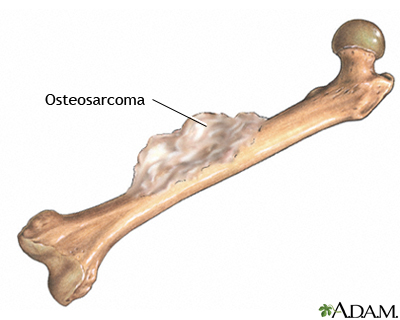
- Benign tumors are not cancer and do not spread from their original (primary) location. They can come back (recur) at their original location.
- Malignant tumors are cancer and may spread cancer cells to other parts of the body (metastasis).
When tumors start inside the skeleton, such as in leg bones, ribs or arm bones, they are called bone tumors. When they start inside other tissues, such as muscles, fat and blood vessels, they are called soft tissue tumors.
Both bone tumors and soft tissue tumors can be either benign or malignant. When these tumors are cancerous, they are called sarcomas.
Benign bone tumors
Benign bone tumors are by far the most common type of tumors that grow within the skeleton. Three types are found most often in children and teenagers:
- Nonossifying fibroma usually is in the actively growing sections of long bones such as the thighbone (femur).
- Exostosis (osteochondroma) contains both bone and cartilage and usually grows in the thighbone, the shinbone (tibia) or the bone in the upper arm (humerus).
- Unicameral (simple) bone cysts are holes in the bone that fill with fluid and tissue. They usually occur in the bone in the upper arm or in the upper part of the thighbone.
These tumors almost never become cancer. Often they are not painful and do not require surgery. If your child does feel pain, they should see an orthopedic surgeon.
Sometimes benign bone tumors clear up on their own and only require that we watch them carefully, checking your child once or twice a year.
In some cases, a benign bone tumor can cause problems while it grows. It can weaken your child’s bone and make it more likely that the bone will break. Tumors also can press on nerves and cause pain. In cases like these, your child may need surgery.
Malignant bone tumors
Malignant bone tumors start inside the bone. They can spread cancer cells to other parts of the body, often through the blood to the lungs.
Among young patients, malignant bone tumors occur most often in teenagers. The two most common types of bone cancer in young people are osteosarcoma and Ewing sarcoma.
A malignant bone tumor can destroy a limb. It also can be life threatening.

Extensive thigh hemangioma. This large lesion involves much of the medial thigh muscles (red arrows).
Soft tissue tumors
Soft tissue tumors form in connective tissues, such as muscles, tendons, fat and skin. They can be benign or malignant.
There are many kinds of benign soft tissue tumors. Common benign soft tissue tumors in children are:
- Fibromas, which usually occur in the hands and feet
- Hemangiomas, masses of blood vessels that show up in many different places
- Lipomas, which are made up of fat cells

Rhabdomyosarcoma age distribution. These tumors are common in infancy and early childhood. They can extend to bone (arrow).
Malignant soft tissue tumors are called sarcoma. Each type of sarcoma is named after the body tissue in which it forms.
Rhabdomyosarcoma forms in the skeletal muscle and is the most common soft tissue sarcoma in children.
Bone and Soft Tissue Tumors in Children

Osteosarcoma. Common (red) and less common (orange) locations are shown. The age of onset in decades is shown in blue.
We do not know exactly what causes children to develop these tumors. Only about two in every 10 children who get malignant bone tumors have a family history of the condition. Benign bone tumors are not inherited, except for the tumor called exostosis.
Children between the ages of 6 and 12 are the most likely to develop benign bone tumors, although the tumors sometimes show up in children as young as age 2.
Exostosis tumors are slightly more common in boys than girls.

Ewing sarcoma. Common (red) and less common (orange) locations are shown. The age of onset in decades is shown in blue.
The bone cancers osteosarcoma and Ewing sarcoma usually begin when children are young teenagers. This is a time when their bones are growing very rapidly and they often are taking part in sports and other physical activities. The most common age at which children are diagnosed with these cancers is 14.
Boys are slightly more likely to get a malignant bone tumor than girls.
Malignant soft tissue tumors are more common in teenagers. Children who are younger than age 6 are most likely to get benign soft tissue tumors.
Bone and Soft Tissue Tumors at Seattle Children’s
To ensure that your child’s diagnosis and treatment is the best it can be, it is important to choose a medical center and doctors who specialize in pediatric bone and soft tissue tumors.
Seattle Children’s has the first clinic in the United States where doctors who specialize in bones, joints and muscles (orthopedists) and specialists in cancer (oncologists) work together in the same program. They are called a multidisciplinary team, and these teams are an important part of Children’s care.
For 20 years, our multidisciplinary team of doctors, nurses and staff in the Bone Tumor and Sarcoma Clinic has specialized in diagnosing tumors and providing exceptional care for children.
Each year we see about 350 new patients at our Bone Tumor and Sarcoma Clinic. About 90% of them have benign bone tumors.
Between 30 and 40 of the children we treat every year have new malignant bone tumors, and each year we diagnose and care for about 30 children with malignant soft tissue tumors.
Doctors from throughout North America refer children to us. We see your child within one week of the call for an appointment. We develop a plan for treatment at your child's first visit.
While our clinic is specifically for children and teens, we work closely with adult sarcoma programs. We share expertise and access to highly sophisticated equipment with UW Medicine.


0 comments:
Post a Comment